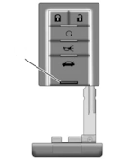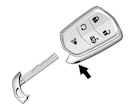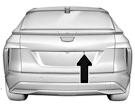On This Page
How to Unlock a Cadillac with a Dead Key Fob
Getting into Your Cadillac
- But first, if you are already inside, click here for help getting started!
- Second, for video help, click here!
- Finally, if you need another manufacturer, click here.
Retrieving the mechanical key
To unlock your Cadillac, you will first need a mechanical key. Cadillac vehicles use three key  fob (remote control or ‘clicker’) styles, and two (GM Styles 1 and 3) have mechanical keys embedded inside. That key will be used to unlock the driver’s door or the trunk (yes, the trunk) and in some cases to remove a piece of the car!
fob (remote control or ‘clicker’) styles, and two (GM Styles 1 and 3) have mechanical keys embedded inside. That key will be used to unlock the driver’s door or the trunk (yes, the trunk) and in some cases to remove a piece of the car!
If your vehicle is the XLR Coupe, a mechanical key is provided separately. Be sure to keep it around!
For Style 1 (above right), press the thin button near the bottom of the transmitter (remote control or ‘clicker’) used to remove the mechanical key. Do not pull the mechanical key out without pressing the button.
 The Style 3 key fob is similar to Style 1, in that the mechanical key is removed from the fob for use getting into the vehicle. To remove the mechanical key, press the button on the side of the transmitter near the key ring, as shown, and pull out the key.
The Style 3 key fob is similar to Style 1, in that the mechanical key is removed from the fob for use getting into the vehicle. To remove the mechanical key, press the button on the side of the transmitter near the key ring, as shown, and pull out the key.
If a key hole is visible at the back of the driver’s door handle, simply insert the key and turn and you’re in.
Getting Inside
 CT4, CT6, CTS, XT4, XT5, XT6, XTS, ATS
CT4, CT6, CTS, XT4, XT5, XT6, XTS, ATS
Many GM models hide the key holes under a cap at the back of the driver’s door. They include the Cadillac CT4, CT6, CTS, XT4, XT5, XT6, XTS and ATS.
*Note the additional Escalade instructions below and that 2020 brings a completely new cap, also below.
To remove the first cap, pull the door handle out to the open position. Insert the key into the slot on the bottom of the cap (3, right). Push it as far upwards as possible and hold upward pressure. Then pry outward. And yes, you WILL feel like you are prying off a piece of your car! Move the cap rearward revealing the key cylinder. Now the mechanical key can be used in the cylinder. Look for a video here to help.
To replace the cap, insert the two tabs at the back of the cap between the black seal and the metal base. Pull the door handle out to the door open position and move the cap forward and press to snap it into place. You can then release the door handle.
Escalade
The Escalade, until 2017, features a new wrinkle in the hidden  key hole. The cylinder is hidden in the same place and manner, but the cap is the top, 1/8 of an inch portion. To remove it, the door handle must be pulled fully open. Then, push the cap towards the handle to release it. It may take a bit of force to accomplish this. See two videos here.
key hole. The cylinder is hidden in the same place and manner, but the cap is the top, 1/8 of an inch portion. To remove it, the door handle must be pulled fully open. Then, push the cap towards the handle to release it. It may take a bit of force to accomplish this. See two videos here.
XTS extra
IMPORTANT! The Cadillac XTS uses both types of caps to hide the key holes shown above. Look or feel for a slot as described with the first cap. If its there, follow the first instructions. If there is no slot, follow the instructions for the early Escalade.
Replacing it is a simple matter of reversing the removal process and simpler than the process needed for the old style.
Escalade, CT5
 In the middle of the 2017 model year, the Escalade, while retaining the hidden key hole, was shifted to the method shown previously. So, starting in 2017, look for a slot beneath the cap. If its there, use the key as described above. Push it into the slot as far upwards as possible, then pry outward. Move the cap rearward revealing the key cylinder.
In the middle of the 2017 model year, the Escalade, while retaining the hidden key hole, was shifted to the method shown previously. So, starting in 2017, look for a slot beneath the cap. If its there, use the key as described above. Push it into the slot as far upwards as possible, then pry outward. Move the cap rearward revealing the key cylinder.
 Then in 2020, Cadillac came up with a whole new cap. As with the first style, there is a slot beneath the cap (right). The handle is first identified by its more curved appearance front to back and a separation near the top. Only the bottom can be removed. It is found on the Escalade and CT5.
Then in 2020, Cadillac came up with a whole new cap. As with the first style, there is a slot beneath the cap (right). The handle is first identified by its more curved appearance front to back and a separation near the top. Only the bottom can be removed. It is found on the Escalade and CT5.
Insert the mechanical key into the slot at the bottom of the handle and push upward all the way until the  cover frees. It will pop out about 1/8 of an inch. Remove the key – do not pry or pull with it. Once free, the cap simply swings up and can be pulled away (right).
cover frees. It will pop out about 1/8 of an inch. Remove the key – do not pry or pull with it. Once free, the cap simply swings up and can be pulled away (right).
With all these options the mechanical key can be used in the now-exposed lock cylinder. We have a video here as well to help.
Remember, getting IN the car is most important. If you have difficulty replacing the cap, don’t. Let your dealer do it when you get a new battery for your Key FOB!
CTS, XLR, ELR
 The CTS, XLR and ELR Coupes have flush door handles (left image) with no key holes
The CTS, XLR and ELR Coupes have flush door handles (left image) with no key holes at all. They have a very different trick up their sleeves.
at all. They have a very different trick up their sleeves.
You must use the mechanical key to open the trunk. The key hole is under the lip of the trunk lid facing the ground.
Once open, you will find a release handle. It is below the forward lip of the trunk (right). Pulling the door release lever will unlock as well as unlatch the driver’s door.
 We have two videos for coupes here.
We have two videos for coupes here.
Lyriq, Optiq and Vestiq
Similarly but more simply, the new Lyriq, Optic and Vestiq EVs also require the trunk or liftgate be unlocked using the mechanical key (right image). The front door will unlock at the same time and the door handles will extend.
Note that if the key simply spins in the cylinder, make sure that the key is fully inserted.
And check the video we made here.
Models examined include ATS, CT6, CTX, Escalade, Escalade ESV, Lyriq, XT4, XT5, and XTS. Model years 2004, 2005, 2005, 2007, 2008, 2009, 2010, 2011, 2012, 2013, 2014, 2015, 2016, 2017, 2018, 2019, 2020, 2021, 2022, 2023, and 2024.
Related: Getting Out!
Continue to Starting Instructions …
——————————————————————-
The information on this website is provided for information sharing purposes only, and should not be used in lieu of an OEM service manual or factory authorized service procedure. We are not in the auto repair business nor do we publish automotive service manuals. Nothing we include on these pages and posts has been reviewed, approved or authorized by any vehicle manufacturer.
Remember that only proper service and repair procedures will ensure the safe and reliable operation of your car. In addition, proper safety procedures and precautions, such as the use of safety goggles, the right tools and the equipment should be followed at all times to eliminate the possibility of personal injury or improper service which could damage the vehicle or compromise its safety.
Technology is always changing and what is current and accurate today may be literally out-of-date and inaccurate tomorrow. And when it comes to the current state of flux in the auto industry, nothing is more true.
The author has 30+ years of automotive experience and has assembled the most extensive collection of symbols and warning lights anywhere (over 1,000!) and can help you open and start any keyless start car with a dead key fob battery. BA, St. Joseph’s, ME: MS, RPI, NY
